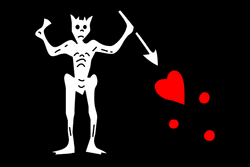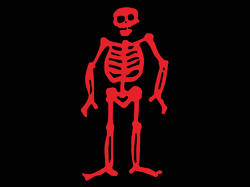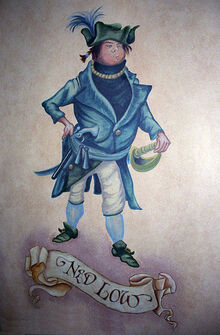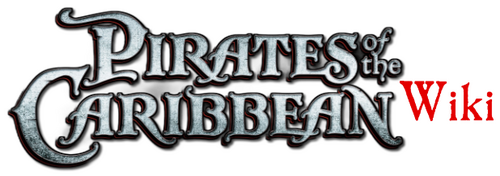- "He used to cut off people's lips, and cooked them, and then make the people eat them. "
- ―David Cordingly
Edward Low (also spelled Lowe or Loe; c. 1690 – c. 1724), also known as Ned Low, was a notorious English pirate during the latter days of the Golden Age of Piracy, in the early 18th century. He captained a number of ships, usually maintaining a small fleet of three or four. Low captured at least a hundred ships during his short career, burning most of them. Although he was active for only three years, Low remains notorious as one of the most cruel pirates of his time, with a reputation for violently torturing his victims before killing them.
Biography[]
Edward Low was born in London, England, around 1690. As a young man, he was said to be a pickpocket and gambler. As he grew older, Low tired of pickpocketing and thievery, and turned to burglary. Eventually, he left England, and traveled alone to the New World around 1710. He spent three to four years in various locations, before settling in Boston. On 12 August 1714, he married Eliza Marble. They had a son, who died when he was an infant, and then a daughter named Elizabeth, born in the winter of 1719. Eliza died in childbirth, leaving Low with his daughter.
At first working honestly as a rigger, in early 1722 he joined a gang of twelve men on a sloop headed for Honduras, where they planned to collect a shipment of logs for resale in Boston. Low was employed as a patron, supervising the loading and carrying of the logs. One day, he returned to the ship when hungry, but was told by the captain he would have to wait to eat, and that he and his men would have to be satisfied with a ration of rum. At this, Low "took up a loaded musket and fired at the captain but missed him, [and] shot another poor fellow through the throat". Following this failed mutiny, Low and his friends were forced to leave the boat. A day later, Low led the twelve-man gang in taking over a small sloop off the coast of Rhode Island. Killing one man during the theft, Low and his crew turned pirate, determined "to go in her, make a black Flag and declare War against all the World."
Pirate[]
Lieutenant[]
Low, using his newly captured ship, lay in wait on the popular shipping route between Boston and New York. Within a few days, he and his crew seized a sloop out of Rhode Island, and plundered it. His crew cut the rigging away to prevent the sloop returning too quickly to port to raise the alarm. He then captured a number of unarmed merchantmen near Port Rosemary.
Low headed south and began operating in the waters of the Grand Caymans, with a period as lieutenant to the established pirate George Lowther, who captained the Happy Delivery, a 100-ton Rhode Island sloop with eight cannons and ten swivel guns. When she was "destroyed by Indians", Lowther and his crew transferred to a sloop named the Ranger. Lowther's crew was constantly expanded by desperate sailors willing to join him.
Following a number of successful raids, Lowther eventually captured a large 6-gun brigantine named Rebecca on 28 May 1722. He gave it to Low to captain. With a crew of 44, Low amicably dissolved his partnership with Lowther.
Pirate captain[]

Edward Low's first pirate flag
In one notable raid in June 1722, Low and his crew attacked thirteen New England fishing vessels sheltering at anchor in Port Roseway in Nova Scotia. Although outnumbered, Low hoisted his pirate flag and declared that no mercy would be given to the fishermen if any resisted. The fleet submitted and Low's men robbed every vessel. Low chose the largest, an 80-ton schooner which he renamed the Fancy and armed with 10 guns, to become his flagship. He sank the other ships of the fleet, and abandoned the Rebecca. A number of the fishermen were forced to join Low's crew.
Of the coast of St. John's in Newfoundland, Low mistook a fully armed man of war for a fishing boat, and barely escaped. He moved on to Conception Bay, capturing a number of boats around the Grand Banks southeast of Newfoundland before crossing the Atlantic Ocean to the Azores. There, he captured a French pink, a narrow-sterned former man of war, which Low rearmed and refitted as his new flagship, naming it the Rose Pink. He also captured an English vessel with two Portuguese passengers aboard. Low had his crew hoist them up and drop them back down from the yard arm several times, until they died. He moved on to the Canaries, Cape Verde and then back across to the coast of Brazil, where he was driven back by foul weather.
Low abandoned his plans for plundering the rich shipping trade off the coast of Brazil, and moved on to the Caribbean. George Roberts, a mate on the British ship King Sagamore, recounted a meeting with Low aboard the Pink. Roberts' ship was captured by Low's fleet, of which he was now styling himself "Commodore".
Capsizing of the Rose Pink[]
Forty leagues to the east of Surinam, Low and his fleet of two ships dropped anchor to remove growth such as seaweed and barnacles from the outside of the boats, necessary because no dry dock was available to pirates. Still relatively inexperienced, Low ordered too many men to the outside of the boat to work on the buildup, and the Rose Pink tipped over too far. The portholes had been left open, and the vessel took on water and sank, with the death of two men. The Pink had been carrying most of the provisions, and Low—by now captaining a captured schooner, the Squirrel—and his crew were forced to strictly ration their fresh water to half a pint per man, per day.
Failing to reach their initial destination of Tobago due to light winds and strong currents, Low's depleted fleet made it to Grenada, a French-owned island. Hiding most of his men belowdecks, he was permitted to send men ashore for water. The following day, a French sloop was sent out to investigate, but was captured when Low's men came out from hiding. Low, now commanding the captured sloop (renamed the Ranger), gave the schooner Squirrel to his quartermaster, Francis Spriggs, who renamed it the Delight before sailing away in the middle of the night with a small crew following a disagreement with Low over the disciplining of one of Spriggs' crew.
Early 1723[]
The new fleet captured many more sloops, including one Low kept, naming it the Fortune. Following this, Low's fleet captured a Portuguese ship called the Nostra Signiora de Victoria on 25 January 1723. The Victoria's Portuguese captain allowed a bag containing approximately 11,000 gold moidores to fall into the sea rather than see it captured. One of Low's most noted episodes of cruelty followed: in his rage, he slashed off the Portuguese captain's lips with a cutlass, broiled them, and forced the victim to eat them while still hot. He then murdered the remaining crew.

Edward Low's second flag
A snow called the Unity was added to the fleet, and used as a tender, but was abandoned during an encounter with a man of war named the Mermaid. As Low's success increased in the Caribbean, so did his notoriety. Eventually, a bounty was placed on his head, and Low set out for the Azores, again teaming up with Charles Harris. As they terrorised the Azores, the pressure increased from the authorities, who by then had taken special notice of Edward Low, despite the hordes of pirates in operation at the time.
Low, Harris and their ships left the Azores for the Carolinas. On 10 June 1723, they suffered a resounding defeat in a battle with HMS Greyhound, a heavily armed man of war. The Greyhound had been dispatched under the command of Peter Solgard to hunt down Low and his fleet. Low fled in the Fancy with a minimum crew and £150,000 on board and headed back to the Azores, leaving Harris and the Ranger behind.
Low sailed north. He captured a whaling vessel 80 miles (130 km) out at sea, and in a foul mood following the encounter with the Greyhound and the loss of his right hand man, Harris, tortured the captain before shooting him through the head. He set the whaler's crew adrift with no provisions, intending them to starve to death. Remaining off the coast of North America, his crew took a fishing boat near Block Island. Low decapitated the ship's master, and sent the crew ashore. When he captured two more fishing boats near Rhode Island, his actions became so savage his crew refused to carry out his orders to torture the fishermen.
Heading south again, Low captured a 22-gun French ship and a large Virginian merchant vessel, the Merry Christmas, in late June 1723. Following the defeat by the Greyhound, Low became "peculiarly cruel" to his English victims. His fleet of three ships rejoined forces with George Lowther in July. In late 1723, Low and Lowther's fleet captured the Delight off the coast of Guinea, mounting fourteen guns on her, with command being given to Spriggs. Two days later, Spriggs and Lowther both abandoned Low, leaving him the Merry Christmas, by now mounted with 34 guns, as his sole ship.
It is unknown what happened with Low after that. He disappeared from the sea, leaving many rumors behind him. Some say that the Low's ship was last sighted near the Canaries and Guinea, another rumor says that Low was sailing for Brazil and another that Low's ship sank in a storm with the loss of all hands.
Behind the scenes[]

Ned Low
- Edward Low currently doesn't appear in the Pirates of the Caribbean universe, but he was mentioned in the Bring Me That Horizon: The Making of Pirates of the Caribbean book.
- Edward Low appears under the name "Ned Low" on a mural on the walls of the Pirates of the Caribbean ride at Disneyland.
- One of the Below Deck: An Interactive History Of Pirates special feature found on various home video releases for Pirates of the Caribbean: The Curse of the Black Pearl DVD/Blu-Ray edition is about Edward Lowe.
- Low's Jolly Roger pirate flag with the red skeleton is used by the Pirate Lord Sao Feng, as noted in its appearance in Pirates of the Caribbean: At World's End, The Pirates' Guidelines, Legends of the Brethren Court: Rising in the East. The flag also appears in the Pirates of the Caribbean: Battle for the Sunken Treasure attraction at Shanghai Disneyland.
Sources[]
- Pirates of the Caribbean: From the Magic Kingdom to the Movies
- Below Deck: An Interactive History Of Pirates
